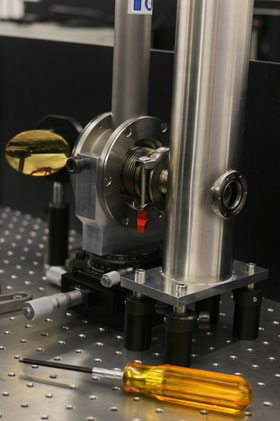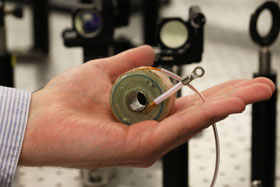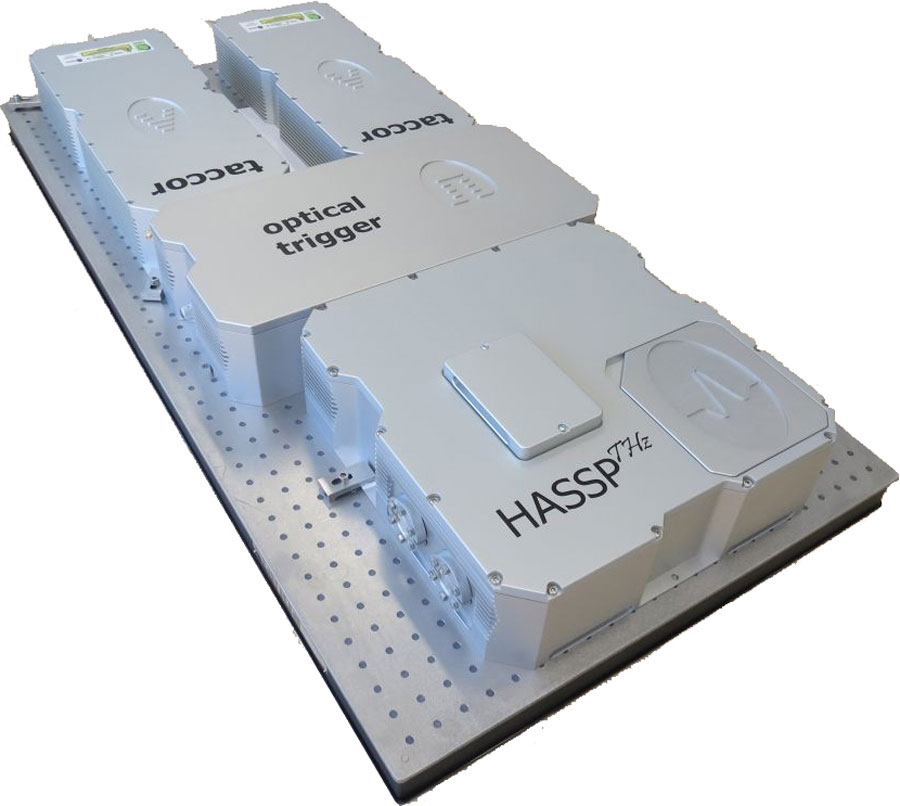From the Journal:

The table-top sized terahertz cyclotron resonance spectrometer
CREDIT: S. Hammersley, The University of Manchester
CREDIT: S. Hammersley, The University of Manchester
Now researchers from the United Kingdom, in collaboration with industry partners from Germany, have built a tabletop instrument that can perform measurements that were only previously possible at large national magnet labs. The measurements will help in the development of next generation electronic devices employing 2-D materials, said Ben Spencer, a post-doctoral research associate working in Darren Graham’s group at the University of Manchester’s Photon Science Institute, who helped develop the new instrument.
The researchers describe their work in a paper in the journal Applied Physics Letters, from AIP Publishing.
Since the 1950s, experiments conducted with magnetic fields have played a pivotal role in the development of semiconductors devices -- like transistors and light-emitting diodes -- that have changed the world.
One magnetic field technique is called cyclotron resonance. In a magnetic field, the charged particles in a material start to move in circles around the magnetic field lines. The orbiting particles interact with light differently depending on properties like their mass, concentration, and on how easily they move through the material. By shining light on the material in the magnetic field and recording what frequency and how much light is absorbed, scientists can learn important information about how easily charged particles move, a critical property in electronic devices.
One of the main obstacles to wide-spread use of cyclotron resonance is that some materials require an extremely high magnetic field to get the charged particles to move fast enough to interact with the light.
Recently researchers created a small, high-powered magnet that can generate fields of around 30 Tesla, about 600,000 times stronger than the Earth’s magnetic field and 20 times stronger than the MRI scanners typically used in hospitals.
The new magnet is compact enough for a tabletop machine, yet the magnet can only generate a field in short pulses that each last for a fleeting one-hundredth of a second.
“The challenge in doing cyclotron resonance with these pulsed magnets is being able to record your data within the brief time period that the magnet is on,” Spencer said. “The breakthrough we have made is in the measurement technique.”

The magnetic coil at the heart of the system was developed by Prof. Hiroyuki Nojiri at the Institute of Materials Research, Tohoku University (Japan). It produces a pulsed magnetic field of up to 30 Tesla
CREDIT: S. Hammersley, The University of Manchester
Spencer and his colleagues used an approach called an asynchronous optical sampling technique to increase the number of measurements during one pulse to around 100. Previous experiments with a similar magnet system were limited to four measurements per pulse.CREDIT: S. Hammersley, The University of Manchester
The team worked with researchers from Laser Quantum, a laser manufacturer, to incorporate ultrafast lasers into the new instrument. The “Taccor” lasers they used run at repetition rates of 1 billion cycles per second, more than 10 times higher than the typical repetition rates for ultrafast laser systems, Spencer said. The fast laser allowed data acquisition times on the order of one ten-thousandth of a second, which meant up to a hundred measurements could be taken during the transient magnet pulse.
“It is this leap forward that will now enable routine cyclotron resonance measurements on a tabletop in a laboratory environment,” Spencer said.
The team tested their system by measuring the properties of electrons at the interface of the two semiconductors AlGaN and GaN. Such interfaces could form an important part of new, energy-saving transistors.
“This work is feeding into a programme of work at Cambridge University on developing AlGaN/GaN-based high electron mobility transistors. These promise much lower power consumption than current devices, which will ultimately lead to energy savings in a wide range of consumer electronic devices. We are also starting to investigate a range of other two-dimensional materials using this instrument, including the new wonder 2-D material graphene,” Graham said.
Ultimately, the team hopes their new instrument could facilitate rapid progress in many areas of semiconductor device development. The system can be easily moved to different universities, and it makes it easy to think of a measurement, and simply perform it the next day, without having to apply for time at a national magnet facility, the researchers say.
“We’re sure that when people realise that we can do such measurements in the lab they will be lining up to use our instrument. We’ve already been contacted by several groups interested in having measurements made on their samples,” Graham said.

The high-speed ASOPS setup including the two turn-key 1 GHz Taccor lasers from Laser Quantum GmbH.
CREDIT: Laser Quantum GmbH
CREDIT: Laser Quantum GmbH
Funding: This work was supported by the United Kingdom’s Engineering and Physical Sciences Research Council.
###
Article title:

No comments:
Post a Comment